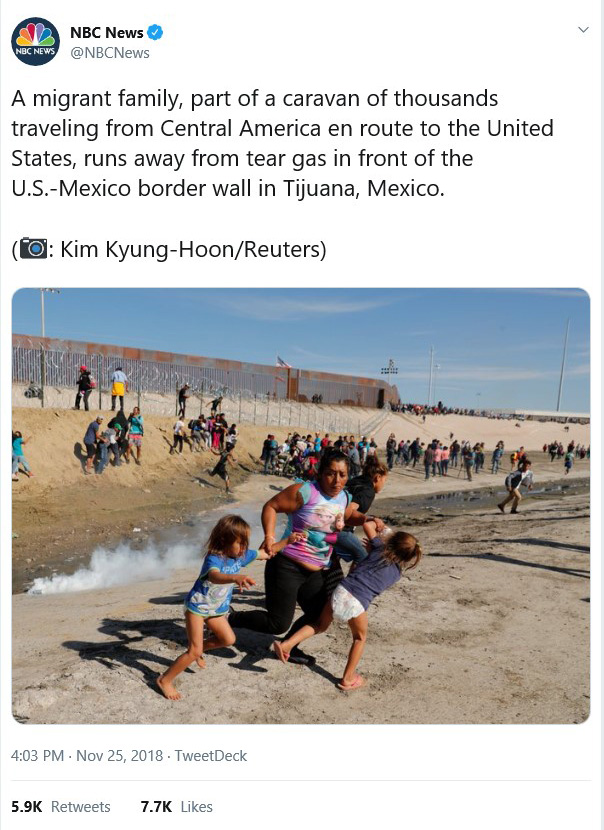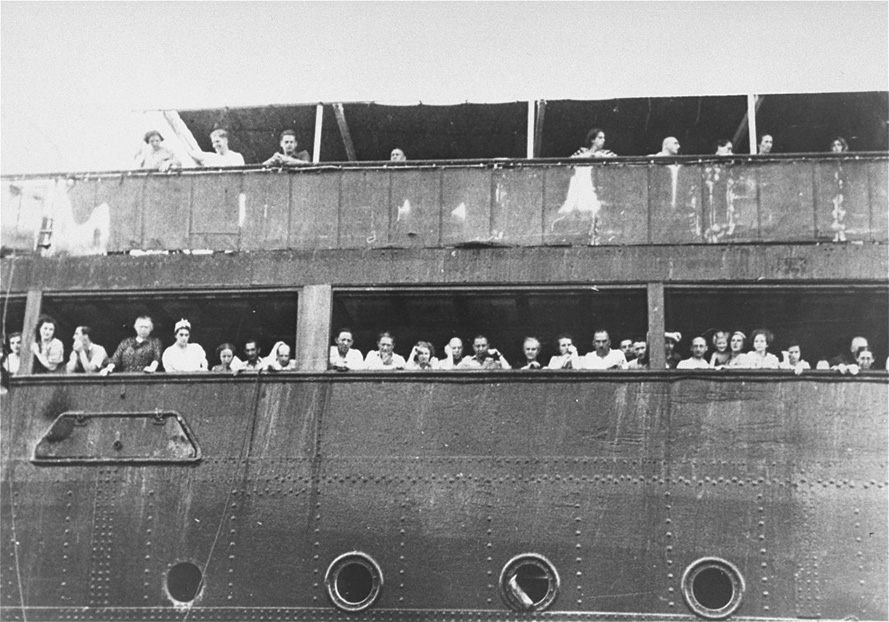Note to the teacher:
This lesson alternates between short chunks of information and discussion questions. Information may be shared aloud or as readings, as you prefer.
Opening
Show students the photograph in this tweet, taken by Kim Kyung-Hoon of Reuters on November 25, 2018:
https://twitter.com/NBCNews/status/1066799500407255040

Share with students: On November 25, 2018, Central American migrants, including children, were tear gassed as they tried to enter the U.S. to seek asylum at the border between Tijuana and San Diego.
- Ask students: What do you know about the term “asylum” or what it means to “seek asylum”?
After students share their ideas, explain or confirm that “asylum” means safety and “seeking asylum” is a type of immigration where people go to another country when they cannot be safe in their home country.
- Ask students if they know whether seeking asylum is legal or illegal. Ask students to move to one side of the room to indicate Legal, to the opposite side of the room to indicate Illegal, or to the middle to indicate Not Sure.
Share with students: Seeking asylum is currently legal in the U.S., but there are restrictions on what situations allow people to gain asylum and what they have to do to prove they are eligible. There is also debate over how to treat the increasing numbers of people seeking asylum at the southern border of the U.S.
Share the following information and text with students. Click here for a pdf version of the readings and questions that follow.
The St. Louis
Show students this photograph of the St. Louis, taken in June 1939, from the U.S. Holocaust Memorial Museum.

Share with students:
In 1939, as Nazism was rising in Germany, hundreds of German Jews tried to immigrate to the U.S. aboard this ship. However, because many other German Jews had also been fleeing Germany that year, the annual limit of German immigrants had already been filled. At this time, there were no laws about asylum in the U.S. People in danger did not qualify for any special immigration privileges.
Ask students:
- What do you think happened to these passengers?
Share with students:
As it turned out, the U.S. refused to let the passengers off the St. Louis, arguing that they had to wait their turn in line to enter the country in future years. The ship returned to Europe and some passengers were allowed to enter other countries, such as Great Britain, Belgium, and the Netherlands. But 254 Jewish people who had sailed on the St. Louis eventually died in the Holocaust.
For more information: https://encyclopedia.ushmm.org/content/en/article/voyage-of-the-st-louis
Ask students:
- How do you feel after hearing this history?
- Does the U.S. bear any responsibility for the deaths of these Jewish passengers?
- Do countries have an obligation to give asylum to people fleeing danger in their home countries? Why or why not?
Share with students:
After World War II ended, the U.S. and many other countries passed official laws about people seeking asylum. One law, first passed in 1952, says that we will grant asylum to people who have suffered persecution or are afraid of future persecution because of their race, religion, nationality, membership in a particular social group, or political opinion.
Ask students:
- How would this policy have changed the situation for the Jewish passengers of the St. Louis?
- Would they have qualified for asylum under this law?
- Why do you think this law was passed?
Who gets to seek asylum?
Share with students:
Under current law, anyone who asks for asylum in the U.S. must be interviewed to see if they qualify as someone who has been persecuted or is afraid of persecution because of their race, religion, nationality, membership in a particular social group, or political opinion.
In practice, who receives asylum often has a lot to do with U.S. politics. For example, when the U.S. was fighting communism in the 80’s during the Cold War, refugees from communist Cuba were treated very differently than refugees from Haiti, which was a military dictatorship and not communist. Both countries experienced political turmoil, both abused people with different political opinions, and in both countries large numbers of people tried to sail to Florida in tiny boats.
However, refugees from Cuba were given asylum and resident status very easily, while refugees from Haiti were stopped in the middle of the ocean and sent back to Haiti without even being interviewed for asylum. The general idea was that Cubans were seeking political asylum, while the Haitians were economic migrants, people immigrating only to improve their standard of living.
For more information: http://www.coha.org/disparities-in-u-s-immigration-policy-toward-haiti-and-cuba-a-legacy-to-be-continued/
Ask students:
- How do you feel after hearing this history?
- Why do you think the Haitians and the Cubans were put in different categories and treated so differently?
- Knowing that the U.S. was very opposed to communism, how did it benefit the U.S. politically to welcome Cuban immigrants?
- Why do you think the U.S. did not welcome Haitian immigrants in the same way?
Then ask students:
- What is the difference between someone seeking asylum and an economic migrant?
- How do you tell the difference?
- Should these two groups of immigrants be treated differently under the law? Why or why not?
Central American Asylum-Seekers
Share with students:
In recent years, courts have debated who qualifies to gain asylum in the U.S.
Consider the case of Rody Alvarado Peña, a Guatemalan woman who was abused by her husband for years. The husband dislocated her jaw, kicked her in the spine while she was pregnant, dragged her by the hair, and raped her. She tried to run away, but the Guatemalan police and courts returned her to her husband.
When Alvarado Peña came to the U.S. and asked for asylum in 1999, U.S. courts decided that although she was legitimately in danger in Guatemala, she did not qualify for asylum because she was not persecuted because of her “race, religion, nationality, membership in a particular social group, or political opinion.” Alvarado Peña kept appealing her case, and after many similar cases of people seeking asylum because of domestic violence or gang violence in their home countries, the official policy changed.
By 2014, U.S. courts had determined that Central Americans suffering domestic violence or gang violence were “members of a particular social group” who were qualified to seek asylum if their country did not protect them from these dangers. But then, in 2018, in an attempt to reduce the number of people seeking asylum, Attorney General Jeff Sessions advised immigration judges to reverse this policy and deny asylum to anyone claiming domestic violence or gang violence.
For more information: https://slate.com/news-and-politics/2014/09/immigrants-seeking-asylum-courts-say-yes-for-domestic-violence-no-for-gang-violence.html
Ask students:
- How do you feel after hearing this history?
- Should people suffering domestic violence and gang violence be given asylum? Why or why not?
- How difficult should it be to prove that you need asylum? Why?
Share with students:
In recent years, the number of people seeking asylum in the U.S. has dramatically increased. In 2008, less than 5,000 people applied for asylum, completing an initial interview showing that they were in too much danger to return to their home country. By 2017, the number was nearly 80,000, most from Central America.
Experts and politicians suggest different explanations for this increase in asylum seekers. Some suggest that the increase is due to greater danger from drug cartel violence in Central America. The homicide rate in countries like El Salvador and Honduras has indeed increased over the past decade. Others suggest that the increase is due to the U.S. allowing new groups of people to seek asylum, especially victims of domestic and gang violence. As people hear that they may now qualify for asylum in the U.S., more and more may decide to come and apply.
Finally, another explanation, preferred by the Trump administration, is that most of these new asylum-seekers are lying about being in danger, and are only migrating for economic reasons, looking for a better standard of living.
For more information: https://www.nytimes.com/2018/11/26/us/politics/migrants-border-trump-.html
Ask students:
- What do you think about these different explanations for the increase in people seeking asylum?
- Which do you think are most likely and why?
Share with students:
In response to the increased numbers of Central American asylum-seekers, the Trump administration has proposed several new policies. One policy was to separate families who were seeking asylum, detaining parents and children in different facilities for months at a time. The ACLU (American Civil Liberties Union) filed lawsuits and many of these families seeking asylum were reunited.
Another policy said that anyone who crossed the border illegally (between official crossing points) could never apply for asylum, but a U.S. court determined that policy to be illegal. The policy is now under legal appeal.
Finally, a new policy has been proposed, called Remain in Mexico. Under this policy, Central Americans applying for asylum would no longer be allowed to enter and wait in the U.S. while their asylum case is processed. Instead, they would have to apply for asylum in Mexico and wait in Mexico until their application is processed, perhaps for years. This policy is just an idea at this point, and may not be legally permitted under U.S. asylum law.
For more information: https://www.npr.org/sections/thetwo-way/2018/03/09/592374637/aclu-sues-ice-for-allegedly-separating-hundreds-of-migrant-families and https://www.nytimes.com/2018/11/26/us/politics/migrants-border-trump-.html
Ask students:
- Why do you think the Trump administration is proposing these policies?
- Do you think the policies, if enacted, would reduce the number of people seeking asylum?
- What other effects do you think the policies might have?
Share with students:
Another new policy is called metering. Usually, anyone who comes to the border and asks for asylum is given the chance to receive an initial interview to see whether they might qualify to apply. However, under metering, only a few people a day are allowed to begin the process. The rest must wait in line at the border.
Metering happened occasionally under the Obama administration starting in 2016, but now metering seems to have become permanent. At the border crossing in Tijuana, for example, there are now thousands of people in line, but the border patrol is only processing 40 asylum seekers a day. On November 25, 2018, in Tijuana, hundreds of migrants approached the border crossing together, but the U.S. Border Patrol closed the border crossing altogether and tear gassed the crowd when they came toward the border fence.
For more information: https://www.vox.com/2018/11/28/18089048/border-asylum-trump-metering-legally-ports and https://www.usatoday.com/story/news/nation/2018/11/28/customs-officials-san-diego-said-because-backlog-they-dont-expect-process-any-recent-caravan-members/2130156002
Ask students:
- How do you think metering is affecting the situation at the border?
- Do you think it will reduce the number of people trying to seek asylum?
- Does the U.S. have any alternate options for dealing with the increased numbers of asylum-seekers?
- Does the U.S. have any moral obligation to people who are seeking asylum?
- What do you think the U.S. should do in this situation?
Closing
Ask students to write or share in a circle their responses to the following:
- What do you think is the greatest challenge for those who come seeking asylum?
- What is the greatest challenge for welcoming asylum seekers in the U.S.?